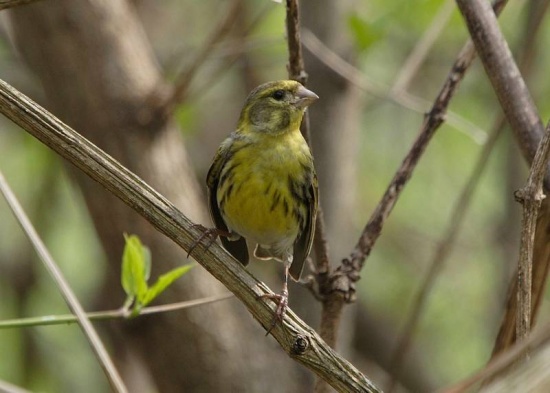(User & Incomplete Templates and Bird Song category added) |
|||
| Line 4: | Line 4: | ||
==Identification== | ==Identification== | ||
| + | 11-12cm. | ||
| + | *Grey green above with dark streaks | ||
| + | *Yellow rump | ||
| + | *Yellow breast with streaks | ||
| + | *White belly with heavy streaks | ||
| + | '''Male''' | ||
| + | *Brighter yellow face and breast | ||
| + | *Yellow wing bars | ||
| + | *Yellow sides to tail | ||
==Distribution== | ==Distribution== | ||
Southern [[Palearctic]]. | Southern [[Palearctic]]. | ||
| + | |||
| + | Southern and central [[Europe]] and north [[Africa]]. | ||
==Taxonomy== | ==Taxonomy== | ||
Monotypic. | Monotypic. | ||
| Line 11: | Line 22: | ||
Open woodlands. | Open woodlands. | ||
==Behaviour== | ==Behaviour== | ||
| + | It nests in a shrub or tree; 3-5 eggs are laid. | ||
| + | |||
| + | The diet includes mainly seeds; insects are also taken in the breeding season. | ||
====Vocalisation==== | ====Vocalisation==== | ||
<flashmp3>Serinus serinus (song).mp3</flashmp3><br /> | <flashmp3>Serinus serinus (song).mp3</flashmp3><br /> | ||
''[[Media:Serinus serinus (song).mp3|Listen in an external program]]'' | ''[[Media:Serinus serinus (song).mp3|Listen in an external program]]'' | ||
| + | ==References== | ||
| + | Wikipedia | ||
==External Links== | ==External Links== | ||
{{GSearch|European+Serin}} | {{GSearch|European+Serin}} | ||
[[Category:Birds]] [[Category:Serinus]] [[Category:Bird Songs]] | [[Category:Birds]] [[Category:Serinus]] [[Category:Bird Songs]] | ||
Revision as of 15:56, 31 March 2009
| This article is incomplete. This article is missing one or more sections. You can help the BirdForum Opus by expanding it. |

Photo by Gwynn
- Serinus serinus
Identification
11-12cm.
- Grey green above with dark streaks
- Yellow rump
- Yellow breast with streaks
- White belly with heavy streaks
Male
- Brighter yellow face and breast
- Yellow wing bars
- Yellow sides to tail
Distribution
Southern Palearctic.
Southern and central Europe and north Africa.
Taxonomy
Monotypic.
Habitat
Open woodlands.
Behaviour
It nests in a shrub or tree; 3-5 eggs are laid.
The diet includes mainly seeds; insects are also taken in the breeding season.
Vocalisation
<flashmp3>Serinus serinus (song).mp3</flashmp3>
Listen in an external program
References
Wikipedia



